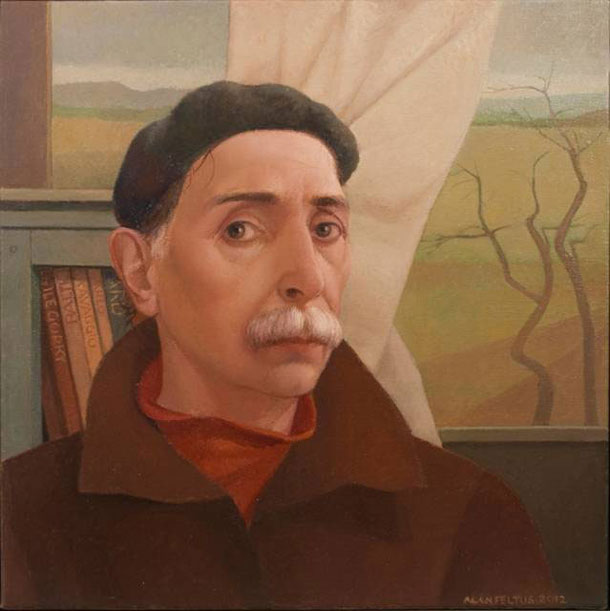
Alan Feltus, Self-Portrait in Studio, 2012, 15 3/4 X 15 3/4 in images courtesy of Forum Gallery, NY
This past summer Alan Feltus and his wife Lani Irwin graciously invited me to visit in Italy at their marvelously restored stone farmhouse with an adjacent studio converted from a barn. Their property, where they’ve lived since 1987, is surrounding by an exquisite flower garden overlooking unforgettable vistas of the Umbrian countryside. I was fortunate to not only view many of Alan Feltus’ paintings in his studio but also to talk with him at length about painting, especially about the incredible artwork in nearby Assisi. Painting Perceptions is very grateful to Mr. Feltus for his generosity of time and energy with this email interview. Tina Engels also contributes important questions to this interview that you read towards the end of the article. Alan Feltus also agreed to our reprinting a 2005 essay he wrote on composition that was previously published in American Arts Quarterly.
Alan Feltus is represented by Forum Gallery, NYC
From the Forum Gallery: … Born in Washington, DC in 1943, Mr. Feltus studied at the Tyler School of Fine Arts and later received a B.F.A. from Cooper Union in New York and an M.F.A. from Yale University. He has received many awards for his work, such as a Pollock-Krasner Foundation Grant in Painting, the Augustus Saint-Gaudens Award from Cooper Union, and the Raymond P. R. Neilson Prize from the National Academy of Design.
Alan Feltus has had one-person gallery exhibitions in New York, Los Angeles and Washington D.C., as well as Chicago, San Francisco, New Orleans and Rome. His work has been included in exhibitions at the American Academy in Rome (New York and Rome), The Joseph H. Hirshhorn Museum and Sculpture Garden (Washington, D.C.), The National Academy Museum (New York), and the National Museum of American Art in Washington, D.C.
He has also been commissioned by the American Medical Association in Washington, D.C., and The Montana Building in New York. In 2001, he received the Raymond P.R. Neilson Prize given by the National Academy of Design in New York. He is also included in several important public collections such as The Arkansas Art Center in Little Rock, AR, The Bayly Museum in Charlottesville, VA., The Corcoran Gallery of Art and The Hirshhorn Museum and Sculpture Garden in Washington, D.C., The National Academy of Art in New York, NY, The Oklahoma City Art Museum and the Wichita Art Museum in KS.
Larry Groff: As a youth you had a unique early exposure to various artists. Your mother and Mercedes Matter shared a house near East Hampton where Jackson Pollack lived nearby and you also visited Alexander Calder’s studio with your mother. You assisted in the studio on 57th street of your mother’s artist friend, Sari Dienes, who became an important early influence. She had well-known artists such as Jasper Johns and Robert Rauschenberg visiting her studio. What was this life like for you back then?
Alan Feltus: When I was a boy growing up in the city, New York was smaller. There weren’t nearly as many art galleries then as there are now and they were on 57th Street and on Madison Avenue, my neighborhoods. Back then the Museum of Modern Art was much more wonderful than it became after its recent transformation into something altogether too large and too crowded with visitors. Their own collection had the best examples of works by the best artists. For a few years we lived on 57th Street, five blocks from MoMA and I went there frequently on my own. I would go to see foreign films in the basement auditorium with its rumbling every time the subway passed. I would enter into the world of those films. I had favorite paintings upstairs I would re-visit each time I was there. The Metropolitan Museum and MoMA were places I loved to spend time in.
Sari Dienes was a Hungarian artist I knew well. My mother rented a studio apartment in the building where Sari had her studio. I was like a studio assistant to Sari in those years, in the 1950s. It was probably more than anything else the atmosphere of her studio that intrigued me. The dim light from large windows and her collections of things she made into her assemblages, most of which were found on her walks in the city. And it was the idea of living as an artist, a maker of things. Sari taught me to see beauty in everything and to be interested in all kinds of things. I hardly knew Rauschenberg and Johns, who were around in those days, because I was a very shy boy, unable to talk to people. I saw their exhibitions and I liked their work.
LG: I understand that when you were in the Yale Graduate program you copied an Arshile Gorky painting of himself with his mother (The Artist with His Mother). What did you learn from this experience and what influence did this give you in your work?
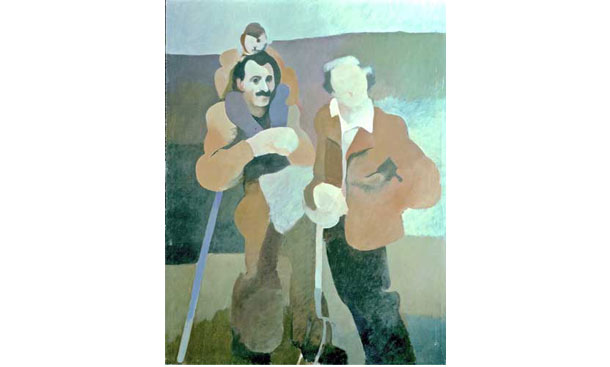
untitled, or “The Gorky that Gorky Never Painted“, 1966 uncertain dimensions oil
AF: That wasn’t exactly a copy of a Gorky painting that I made. My idea was to paint a Gorky that Gorky never painted. It was an indirect kind of copy. I worked from a photograph of Arshile Gorky with his daughter, Maro, on his shoulders standing next to André Breton in the landscape. I was looking at the photograph of Gorky as a boy with his mother taken in Armenia from which Gorky made two paintings and several drawings. I was very interested in the paintings by Gorky and de Kooning and also John Graham, whose work I only got to know when I started that project. It was their early figure paintings from when they and their paintings were quite close that I wanted to know as well as I could. I wanted to internalize how those paintings were made.
In the early figure paintings by those three painters I saw how painting had transitioned from the late 19th century, through Cézanne, and into the 20th century; a bridge between past centuries of figurative painting and a kind of abstraction that was still figurative and relevant in our time. In their paintings there was a kind of re-inventing of the figure into something very elegantly stylized, with a flatter space and clear reaffirmation of the picture plane.
I absorbed what I could of their early figurative paintings and how each of their work moved into a more nonobjective abstraction without losing the elegance of form characteristic of the earlier figures. I was too young to begin to know where my own work was going to go, so borrowing what I learned from immersing myself in their visual language gave me something from which I could gradually find what would be my own. I let the Gorky-de Kooning-Graham influence carry through my paintings until it dissipated on its own.
LG: Do your paintings have autobiographical elements to the narrative and a reason for painting similar themes over and over.
AF: What I paint is, in some respects, my interior world, so, yes, my paintings can be seen as partially autobiographical. They have qualities like stillness and quiet that I seem to need in my paintings, and that probably has to do with growing up as a very shy and introverted child in the shadow of a beautiful but very difficult mother. I was a silent observer taking in all kinds of things that formed who I was, and who I would become as an artist.
In 1993 I made a series of paintings about myself and my mother. The theme was somewhat related to Gorky’s mother and son paintings, but it was unlike those in that what I wanted to do was to see if I could better understand how I managed to survive the very difficult relationship I had with my mother. The first of those paintings had a young boy standing with a few toys at his feet, looking anxious while his mother was self absorbed reading, paying no attention to the boy. Neither of us was like myself or my mother in appearance, but I put symbolic things in the painting that were specifically about us. My mother was in her nightgown, with her I Ching book and the three coins she used to find specific passages that would address questions she had about her life. My toys were minimal, as in those early years we moved back and forth from cheap hotel rooms to the apartments of my mother’s friends when they would be on vacation, with very few possessions, living out of suitcases with little sense of security. The other paintings in that series were about my adolescent years, living with my mother in Rome, where we were for my last year of high school.
I paint figures in interiors with a few pieces of furniture and often newspapers or letters on tables or on the floor or being held by a figure. I repeat imagery of that sort because that is what I want to paint. I am interested in the psychological play that can be variously interpreted between my figures. So it becomes over and over that I paint similar imagery, but no two paintings are the same. I can think of many painters whose paintings are very much more alike than mine. They I question. Myself, not
LG: How much does your history and personality affect your painting? Conversely, how much does your painting affect you as a person?
AF: My paintings have to be about myself. For that not to be so would mean I paint meaningless paintings, or paintings about things chosen randomly. A teacher might assign a subject or an idea for students to work from. An illustrator will be asked to illustrate a given idea or product. Centuries ago all painters illustrated Biblical or historical stories, or made commissioned portraits. Their challenge was to make great works in spite of those dictates. Given the freedom we have today, I would hope artists would work with what is inside of them in some way.
My identity as a person is largely tied to who I am as a painter. I can be anonymous when I am out and about, separate from the paintings I make, unknown to people around me, and that anonymity is good. I can’t be away from my studio for an extended period without starting to feel lost, as though I don’t know who I am and what I’m supposed to be doing. It’s a disconcerting feeling. I like when I meet someone who already knows my work. But, like the rest of us, I am a person affected by all kinds of things other than, and in addition to my work.
LG: You spent time in Provincetown when the elderly Edwin Dickinson was living there. You’ve stated that Edwin Dickinson is one of the contemporary painters you admire most. Can you share some of your thoughts about Dickinson and why a painter whose work is often observation based has such appeal for you as a studio painter working primarily from invention and memory?
AF: Dickinson painted from observation in his large figure compositions, and his self portraits, and in his smaller fast landscape paintings, but his paintings are not very much like what he observed. That, of course, is true of almost all painters painting from observation, but in Dickinson’s case, more so than most. What Dickinson did with his figures in their large cluttered interiors and his very strong, often almost fierce, self portraits, and his partly smeared quick landscapes is his alone, and that interests me a great deal. I don’t separate those who paint from observation from those who work from invention and memory. I see paintings, and not kinds of paintings. And I think what I consider to be good paintings are going to mix observation with something else. That can’t be helped. A thousand choices are made while the landscape or the still-life painter or the maker of portraits works.
LG: I’ve read that Edwin Dickinson’s The Cello Player, Henri Rousseau’s Sleeping Gypsy, Felice Casorati’s Susanna, and The Artist and His Mother by Arshille Gorky are the four most influential contemporary paintings to your work.
Would you care to say something about why such an unexpected selection?
AF: Dickinson’s Cello Player was hanging in what is now called the Smithsonian American Art Museum when I started teaching at American University in 1972. It has a figure playing a cello surrounded by beautifully painted teapots and books and instruments seen from above in a subdued light. I liked the grays ranging from a delicate mauves to earth yellows and umbers. I liked the quiet of the painting. I liked its scale. So it talked to me. And that kind of knowing paintings will exert some influence on my own work.
I have loved Rousseau’s Sleeping Gypsy since I was about ten years old. It was one of the paintings I would stand in front of at the Museum of Modern Art. Although Henri Rousseau is considered to be a primitive painter, and the little I remember reading about him as a person suggests both he and his paintings were naive, I find his Sleeping Gypsy to be purest poetry. In what may be a contrary way of thinking, I have sometimes said Rousseau’s Sleeping Gypsy is more sophisticated than the paintings of Monet, because Monet was just interested in capturing the light of different times of day on haystacks, or on a church facade. That isn’t about poetry, that’s a mechanical exercise compared to the poetry in a good Rousseau.
When I was painting at the American Academy in Rome (1970-72) Felice Casorati’s Susanna was hanging in the in the Galleria Nazionale d’Arte Moderna e Contemporanea, in the Borghese Gardens. That one painting was the one that interested me most in the whole museum. I saw that painting as having everything I thought I would want in a painting of mine. It had a nude woman and a clothed man, each sitting on a chair, and a third a chair, a few objects, newspapers on the floor and a bit of the architecture of the room space. And I loved how it was painted. It was there in my studio at the American Academy that I found the direction my work was going to take, and that single painting was key to that. Casorati is one of many very good Italian figure painters working mainly between the wars who interest me. Of those only de Chirico and Morandi were known to most American painters and students. Fortunately, now their work can be seen on internet.
The Artist and his Mother by Arshile Gorky is mentioned above. Those four paintings might be my selection of the four most influential single paintings for me. Of course there are many, many paintings and many painters who have been very important to me over all the years I have been painting.
LG: Balthus would also seem an artist that influences your work, can you say something about what his work means for you?
AF: Balthus isn’t among those four painters named above because your earlier question was about what four single paintings most directly influenced my work. Rousseau isn’t one of the artists who most influenced me. That particular painting, The Sleeping Gypsy, had a place in my life from long before I went to art school, before I became familiar with the work of Balthus. I have learned a lot from Balthus because there is a strong and deliberate concern for composition in nearly all his paintings. The Street, painted by Balthus in 1933, also hung in the Museum of Modern Art, and it also had a strong influence on my work. But it would be several Balthus paintings rather than a single painting that have spoken to me.
The Composition of Paintings: An Artist’s Perspective by Alan Feltus
Originally written in 2005 and printed in American Arts Quarterly
Figurative paintings, like abstract or nonobjective paintings, want to work in formal terms, quite apart from their image and their associations. A painting may be about a person sitting on a chair in a room, but it is also a complex fitting together of shapes that can be appreciated as such, apart from any representational reading..My own paintings, although carefully rendered and perhaps seen as realism, are invented images with all manner of visual distortions and unreality. In my paintings, composition is intuitive by nature, rather than based on any imposed system where the placement of forms is governed by a geometric framework A painting that is organized intuitively is arrived at by instinct, maybe quite unconsciously. I have always liked painters whose compositional structure is as apparent as their narrative content, from Giotto and Piero della Francesca to Balthus. For me, a painting wants to achieves a balance between the structural language and the subject matter.
What are the aspects of intuitive composition? First of all, the need to find a balance must be central in such a discussion. We relate to balance in an image as we do in real life. Things in equilibrium are stable and not disturbing. I like quiet paintings. My paintings have to be stable and quiet in order to work for me. Some painters need disquiet. (Compare the seventeenth-century paintings of Vermeer and Jan Steen, painters from the same culture yet totally different in this way). Balance is intuitive. We achieve it automatically as we paint, each of us having our own kind of balance. Things adjust in position until they are within equilibrium.
LG: Ingres’ manner of painting the figure would seem to be something you’ve thought a great deal about. Your figures are precisely drawn but more to satisfy the needs of the painting or to get at some mysterious quality rather than wowing us with verisimilitude. What are your considerations when drawing and painting the figure?
AF: I want, and seem to need, to have paintings create a kind of quiet that is conveyed by how figures are drawn and painted, and how paintings are composed. It is due to the arrangement of figures and how everything can be so carefully considered that in a finished painting nothing should be able to be shifted, or eliminated. Nothing new can be introduced. I think all paintings I like have that in common.
Ingres redesigned human anatomy and created a rarified, unreal world rendered so exquisitely that we accept it all as real. When I see paintings that do that I tend to like them.
LG: There is often an unusual geometric and gestural configuration underlying how the figures relate in the painting. You don’t use models other than looking in a mirror, how much does other art play a role in your composing? Can you say something about how you go about making a painting?
AF: I don’t compose a painting with any structural system in mind. The structure comes intuitively. I start painting directly on the white oil ground of a stretched canvas. I make a few pale marks that might be the two sides of the torso of a figure. And the same with a second figure, watching the interval between the contour of one figure and the next, and watching those in relation to the edges of the canvas, I continue to put pale brush marks on the white ground, making changes and covering the white of the ground. Within minutes I will be redrawing what I see there, adding arms and legs, and necks and heads. The parts of a chair might be suggested, and maybe the line separating floor from wall. A diagonal shadow across the floor. I’m looking at what will be solid parts of the figures and what will be the spaces between those. I might put a table top in the bottom of the painting that in effect pushes the figure back a little in the space. And I might put some objects on the table top.
That will go on for days, with changes, and scrubbed out painted over lines. Limbs moved. White ground being covered in a tentative color, a little less pale now. Form becomes more solidified. Figures emerge and move about. And I’m watching what the painting is about almost as though it’s not me painting it. An idea might emerge that I hadn’t started with. I might see a female nude and another figure that might be a man, or it might be another woman, maybe partly clothed. And everything remains subject to revision until things find their places, and then I repaint what is there until I’m satisfied with what I have.
I take breaks to look at books. Casorati and Balthus. Degas. It isn’t that I get ideas from seeing other paintings so much as I am being encouraged by looking at great paintings, or having something like a kind of color being suggested. I stop painting when the daylight fades and start again the next day. I begin a second painting when the first is at a state that excites me in some way, when something promising suggests itself.
When I have two canvases started and both are covered and there is no more white ground showing, and many adjustments have already been made, then I usually stay with one of the two canvases until it is close to being finished, and then I put the other one on the easel. I use mirrors all the time to better understand the form of anything I can see of myself in the mirror. Not using models is both making things harder for me and giving myself greater freedom. I started painting without a model when I didn’t have the money to pay a model, and I grew to prefer being alone in my studio. Then working without a model became how I worked, without questioning it.
LG: Early Renaissance painters like Giotto, Piero, etc are clearly an influence in your work. I’ve read that you also used photographs that you took of Roman Portrait busts as source material for some of your paintings.
Have you ever sculpted? What attracts you to the roman portrait bust? Can you say something more about this?
AF: I rarely use a photograph of a Roman portrait sculpture or of a head from a painting by someone else or a photograph of a person in my paintings. Sometimes I photograph sculptures in museums from all sides and angles thinking I will use them as source material, but I rarely look at those photos. It is more the quality of the sculpture or painting that has an influence. It’s subtle and indirect and I may not realize I am being influenced by something that way. I look at those things some when I find I need to understand the structure of a head in a particular position my figure is in, but usually I don’t find an image that matches the position of a head or the direction of the light in my painting. So I am left to struggle with my memory and my mirrors.
LG: Your figures sometimes have an androgynous quality, is this something you think about?
AF: No. I think that is part of what happens in my paintings without much thought. But I do have kinds of faces and bodies that I like and others I dislike. When I paint looking at myself in a mirror I tend to make what I paint look younger and more beautiful than what the mirror reflects.
LG: Your figures often stay within a certain age – rarely very old or very young. Have you ever made a figure in your painting that you’ve fallen in love with? Do your figures result from any sense of an ideal form or beauty?
AF: Have I ever made a figure in a painting that I have fallen in love with? Interesting question. No, I’d like to experience that, though.
In Greek mythology Pygmalion fell in love with his sculpture of a very beautiful woman, and in that story she came alive. In my life, rather than in my paintings, in a sense that happens. I have such experiences with very beautiful women I see somewhere, but that stays nicely within my fantasies. The figures in my paintings usually fit within that younger age when people are more beautiful. They are nicer to spend my studio days with. However, occasionally that changes. A few years ago I made two paintings about me getting older and dreaming about being again with a beautiful young woman. So in those the man is older. One was more or less a self portrait and the other not.
My idea of ideal beauty I do work with.
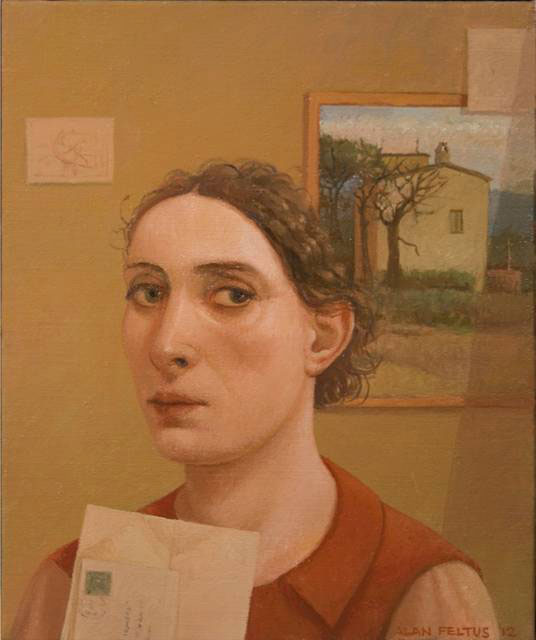
Her House, Her Tree, 2012, 11 3/4 X 9 7/8 in., oil on linen.
LG: I was very touched by your marvelous gift of some 1911 stamped envelopes and letters from Milano with outstandingly ornate penmanship that you bought at a flea market while I was visiting you in Assisi this summer. For many years your paintings often depict people with letters, envelopes, blank sheets of paper, or perhaps a newspaper. What do these letters mean for you and where are these letters coming from?
AF: I collect old letters. The monthly antique markets always have envelopes and postcards and only the ones with stamps of significant catalogue value are expensive. I buy a few each time I go to the markets. They have stamps printed in a single color and beautiful calligraphy. Only once did I copy an actual stamp on an envelope in a painting. I make up the stamps and the writing. They are not clear enough to see in any detail. I paint envelopes and pieces of paper in my paintings for their compositional meaning and because I like how a letter is from, or to, someone outside the image of the painting. That changes the narrative in subtle ways that I like. I think, maybe the letters and newspapers in my paintings started when I saw Felice Casorati’s Susanna in the museum in Rome in 1970, but I can’t be sure because I have always liked envelopes and stamps and how various painters painted newspapers, creating the sense of columns of print and headlines without anything actually being legible.
LG: Your paintings would seem to be a psychologist’s delight. Your figures have an enigmatic emotional tone that often suggest existential, sexual, and perhaps philosophical mysteries. Have you ever talked to a therapist about your paintings?
AF: No. I haven’t talked to a therapist about my paintings. I believe the paintings that don’t have those kinds of mysteries are likely to be the ones we find boring, We should be grateful that therapists haven’t had their way with painters.
LG: Your work celebrates the slow, quiet, meditative, qualities in painting. Like most really great paintings, they slowly unravel with repeated close looking in front of the actual painting. With this in mind, what are your thoughts about the shortened attention spans and where many people are more apt to snap a cellphone photo than to spend much time standing and looking closely at the painting. I read recently where a museum studied the average time viewers spent in front of a painting, was something like 10 seconds. Does painting in this Attention Deficit Disordered future ever worry you?
AF: No, I am not worried about that. A study like that is meaningless. I will walk through museums filled with great paintings and only stop in front of a few of them. If I stop in front of one painting for ten minutes (and that one painting might be one I have stood in front of for many hours over many museum visits) what does that do to the average time I spent in front of a painting in such a study? I believe my paintings, and the paintings I like made by other painters, can be visited over and over, and can be seen in memory and thought about when we are no longer in their presence. And there is nothing new in that. We paint for ourselves and for those who will spend time looking at paintings.
LG: Your subject matter of a few figures in an interior has been remarkably consistent over the years. Do you ever want to paint something completely different?
AF: No, I seem to want to stay with my kind of imagery. I haven’t lost interest in what I do. I don’t feel as though I am repeating myself and I’m not sure that would bother me if I did. Think about your own favorite painters of all times and countries. Generally their work stayed fairly consistent through their career, or at least in their mature years of making paintings. For me it is the painters whose work hardly holds my interest even for a few seconds that I wonder about how they stayed so long within one kind of imagery. How did they have a continued appreciation for what they were doing? I think often it was success that urged such artists to keep repeating what they were known for, to supply works for an eager market. That’s not my game.
LG: I read where you once said “That which is not about technique is harder to teach, or maybe impossible to teach”. What is the most important point you’d like to get across in your lectures and teaching?
AF: One can learn to render exquisitely so that figures and objects might look astonishingly real, but that skill has little to do with good painting. it can also be part of great painting, but it is not a prerequisite of good painting. The technique to render flawlessly is teachable, and is taught by painters who probably learned those techniques from teachers who in turn, in my opinion, didn’t understand what makes great paintings.
I tried to teach how paintings are constructed, referring to the paintings I found most important. Students begin their studies with little or no understanding of composition and of what separates a great painting from a lesser painting. I tried to instill in students a passion for learning and a sense that finding one’s self is what matters most, and that that takes years.
LG: How does one make extraordinary paintings?
AF: We can ask ourselves what paintings interest us most throughout the history of art. And then we can ask ourselves why we chose those paintings. And we might start to find answers to those questions. The answers will be personal. Some of us love paintings others of us dislike. And that is how it should be. I talk to students about what makes some paintings extraordinary, what makes one painting of the same subject matter stand apart from hundreds of other paintings of that subject matter. The answers to that question will vary from one person to another. But it is in thinking about such questions that answers begin to come.
Questions from Tina Engels
Tina Engels: Your paintings convey subtle tones of color and light that as a whole emanate overall warmth. Do the warm tonalities reference the warm Italian light, specific painters of interest to you, specific genres of painting or is it something else you are drawn to?
AF: I don’t know the answer to that. It may be all of those things, but the way I understand it, my color is what I have to have in my paintings, like the quiet. I paint out bright colors if they creep in. I like a kind of unity of color, a rightness of color within a painting. And in the simplest of terms I dislike a painting that is all warm or all cool in color. There has to be some of one with the other. I want my paintings to feel as though they have air, and that has to do with color. And the color of a painting wants to stand out as being exceptional, whatever its nature is.
I work with a rather limited number of colors and those are intermixed or adjusted in slight ways by mixing complimentary colors together. That is, a red will be reduced in its redness by a little green, and so on. But I do that kind of adjusting without thinking.
TE: The paintings create the subtlest arabesques and fluidity of form. Is this something that evolves in the construction of the work or an abstract element pondered in advance and would you be willing to discuss the creation of these varied rhythms that seem so important to the work?
AF: Nothing I do is pondered in advance of starting a painting. Everything results from seeing what emerges on the canvas in front of me and reacting to that, triggering a series of adjustments. And that continues for weeks or months as I work on a painting. But this is me. Other painters work very differently. There is no right or wrong way to make a painting, more or less, assuming we are talking about good painters.
TE: On Giotto and the cycle of 28 frescoes in the Upper church of the Basilica di Saint Francesco in Assisi, would you be willing to comment on the authorship of these frescoes, do you have and thoughts on Giotto as auteur or not?
AF: First of all, I want to say that those are extraordinary frescoes, and the question of attribution exists because there are no documents stating that Giotto was paid X number of gold florins for his work in the Basilica of San Francesco. And there are no documents indicating who other than Giotto painted them. Giotto was the most celebrated painter of his time, so all the Italian books and postcards state that those are Giotto’s frescoes. But they are not all that much like the undisputed Giottos, such as those in Padova. Whether Giotto painted the frescoes or another artist painted them, or perhaps students of Giotto painted them, makes no difference to what they look like. They and the other frescoes in the basilica are wonderful. The totality of the basilica, built on two levels, one atop the other, every inch frescoed, is what brought Lani and me to settle in the hills outside of Assisi in 1987.
About a year and a half ago Lani and I met Mark Webber in Naples and we looked for frescoes by Pietro Cavallini that Mark had on a list. Pietro Cavallini was believed by some scholars to be a likely painter for having painted the Assisi frescoes in question. The last place we visited was Santa Maria Donnaregina Vecchia. It is a little known, hard to visit church next to the church of Santa Maria Donnaregina Nuova. There we saw three enormous walls painted by Pietro Cavallini in four horizontal tiers extending up to a great height, and more of them, and more amazing in quality, than any of us had begun to expect to find. So, maybe the Assisi Giottos of the Upper Church of San Francesco were painted by the Roman painter, Pietro Cavallini.
TE: You have a unique artistic relationship with your wife Lani Irwin and your sons, Joseph and Tobias Feltus. Would you share something about how your familial artistic community has influenced your work?
AF: Certainly there are various influences between the four of us. And at the same time we are each distinctly separate in our work, except for when we collaborate. Tobias and Joseph have collaborated on photography and film projects, and to some extent Lani and I have collaborated with Joseph on short films. I made a lot props and parts of sets in 1 to 6 scale for the film Joseph is working on now. And Lani and I and Tobias made some props for Joseph’s award winning film, Solo Duets, a few years ago.
My interest in Gorky’s paintings and Balthus’ paintings has been shared by Joseph, as can be seen in his films, but I’m not sure how much or little any of their work has influenced my painting. Lani and I have been together 42 years sharing studios and discussing paintings, so there will have been influences both ways between us. Certainly having the continual support of a very creative family has helped me to be the painter I am.
Most images in this article courtesy of Forum Gallery, NY
by Alan FeltusFigurative paintings, like abstract or nonobjective paintings, want to work in formal terms, quite apart from their image and their associations. A painting may be about a person sitting on a chair in a room, but it is also a complex fitting together of shapes that can be appreciated as such, apart from any representational reading..My own paintings, although carefully rendered and perhaps seen as realism, are invented images with all manner of visual distortions and unreality. In my paintings, composition is intuitive by nature, rather than based on any imposed system where the placement of forms is governed by a geometric framework A painting that is organized intuitively is arrived at by instinct, maybe quite unconsciously. I have always liked painters whose compositional structure is as apparent as their narrative content, from Giotto and Piero della Francesca to Balthus. For me, a painting wants to achieves a balance between the structural language and the subject matter.
What are the aspects of intuitive composition? First of all, the need to find a balance must be central in such a discussion. We relate to balance in an image as we do in real life. Things in equilibrium are stable and not disturbing. I like quiet paintings. My paintings have to be stable and quiet in order to work for me. Some painters need disquiet. (Compare the seventeenth-century paintings of Vermeer and Jan Steen, painters from the same culture yet totally different in this way). Balance is intuitive. We achieve it automatically as we paint, each of us having our own kind of balance. Things adjust in position until they are within equilibrium.Another crucial aspect of composing is how elements relate to one another and to the edges of the canvas. Paintings should not look like randomly cropped pieces of something that continues beyond the edges of the canvas. A painting is an object, complete and unique unto itself, different from the world around us. A painting is a transformation of something observed or invented. Transformation is necessary.
To understand the relationship between composition and the recognizable subject, think of Picasso’s Cubist paintings. What we see is an abstracted image, which might portray some objects on a table in a room, but is above all a collection of shapes and colors and textures that reflect, or relate to, the vertical and horizontal edges of the picture plane. It is a construction that is very much about underlying structure. We assume that music and poetry are based on underlying structures. As children we learn about the way words and notes are organized to create form. Paintings also depend on such structures.
We don’t refer to Cubist paintings as realist, of course. Realism, in any of its guises, tends to lose this balance between formal structure and image. For me, that is a problem. Too often we read the image and miss the painting.
Completely abstract paintings, in which there is no figure, landscape, still life or other subject, are about composition itself. We see the paint as paint. We see the color and texture and value and the way paint was applied, the gestural touch of the painter’s hand..
I think of myself as choreographing figures and objects when I make a painting. A painter has complete control over the precise relationships between forms. Everything can have an exact position and character that will remain forever unchanged. This fixedness is unique to painting (and photography). The painter wants to find the most perfect visual arrangement of forms he can find. When a painting is finished, it should be that nothing can be moved or added or taken away without upsetting the whole of the painting. One doesn’t want be haunted later by inadequacies not seen while painting. Of course, this is a near impossibility.
If every element in a painting is a part of the composition, then any line or color, any object or any space between objects, has been positioned, and then adjusted and adjusted again, to work in a precise way with everything else. This holds true for the division between floor and wall, the shape of a cast shadow, the presence of a book or a teacup. If I paint a piece of drapery or a piece of paper on a chair, that element is there because it has a compositional purpose. It might serve to continue a visual line across the painting’s surface, establishing a relationship to those several parts that now line up in a particular way; at the same time, it might help define the way space reads in the painting. A piece of paper painted in perspective becomes a tipped plane. Placed on the floor, such a shape can hold an otherwise ambiguous area of color down as a floor and thus define the space. If the feet of a figure or the legs of a chair are not within the edges of the picture and are therefore not seen touching the floor, the space behind or next to the figure might read as wall—unless we place some shape there that would hold it down as floor. We can create a whole complicated patterned floor drawn in perspective, or we can paint, in effect, one square of a checkered floor that serves the same purpose. Of course, spatial ambiguity is sometimes also desirable. Wall can read as wall and at the same time as floor and not wall. Any element, such as the piece of paper on the floor, can serve many purposes. It will also be given a gesture. In terms of the narrative within a painting a tipped plane may be an envelope or a letter, introducing associations that would not be there if that something were a small piece of cloth
Every form in a painting is given a gesture. Gesture does not belong exclusively to faces and body language. A piece of drapery, a book or a chair or a piece of floor seen between the other objects can be said to have gesture. An artist makes forms as he makes gestures. He can’t help it. In fact, it is this quality that allows us to recognize the hand of a particular artist in a small detail from an unfamiliar painting.
We are who we are as artists because of what we paint and how we paint it, but we are also defined by our limitations. It matters what we want to make and what comes forth as we work—intentions informed by knowledge and desire, subject to our best abilities and our limitations. I see my limitations as part of my identity as a painter, and I know the struggle involved in the making of any painting is necessary. I usually consider paintings that seem to have been made without struggle to be suspect. Painting is very difficult work, requiring endless patience.


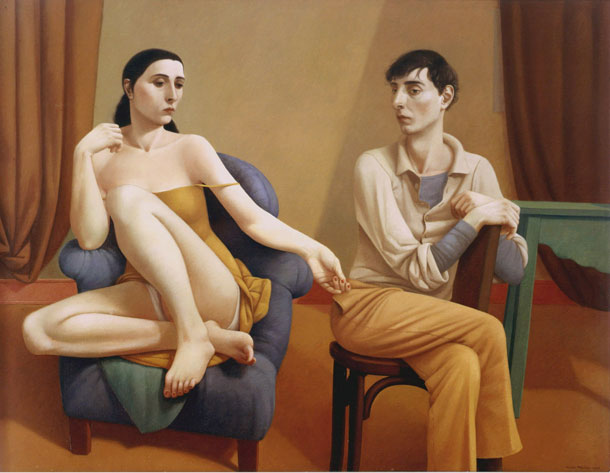

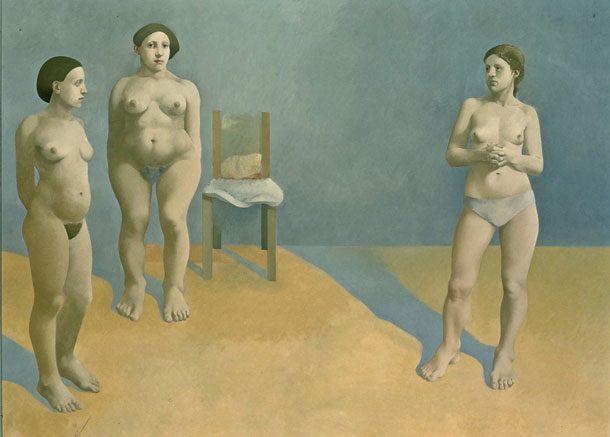
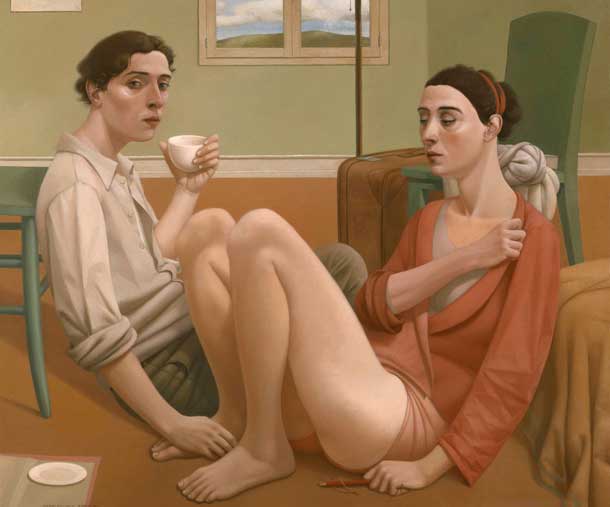



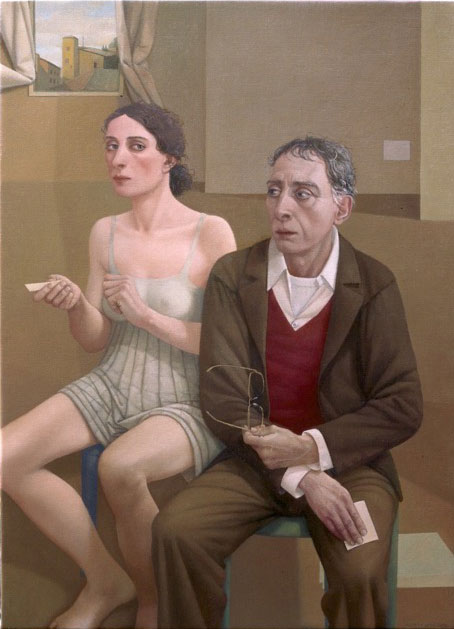
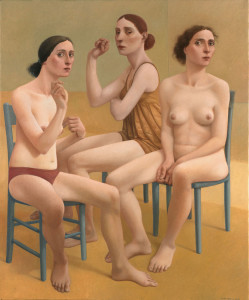
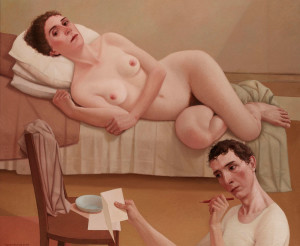

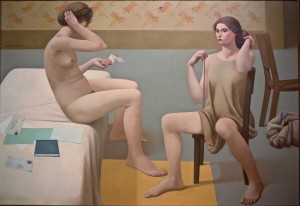
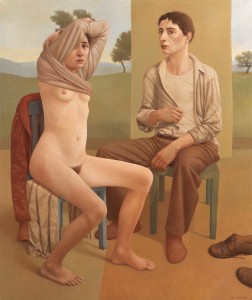
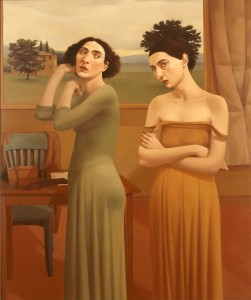
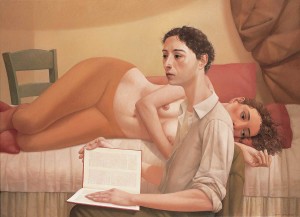
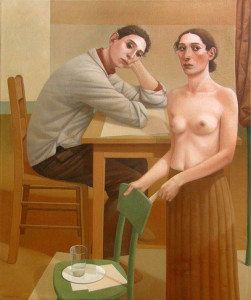

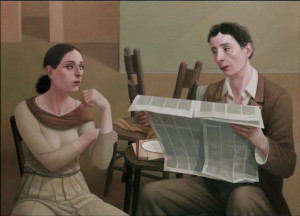
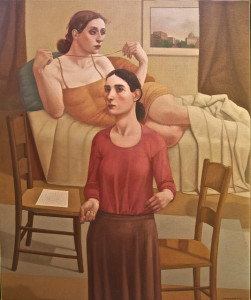
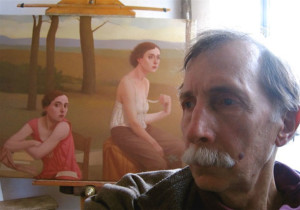




Lovely interview, Larry. This was a delight. Feltus’ paintings have always been an inspiration. Thanks so much.
I became an instant FOF (fan of Feltus) when I saw one of his paintings in a neighbor’s apartment in the late 1990’s Nothing would do but that a Feltus would come to live with me. Now I have two works that I love very much. Thank you Alan for enriching my life.
great questions, great comments and most of all, great paintings! Compliments all around.
I had the pleasure of taking classes with Alan Feltus and Lani Irwin years ago at Montecastello di Vibio, at The International School of Painting, Drawing and Sculpture and this has had a lasting and life changing impact – their work, their intellectual rigour and another way to look at and think about painting, was unique in my experience. A privilege. Feltus’s quiet regard and compositional intelligence and erudition and Lani’s constant intellectual inquiry and discipline, that experience remains with me, and sustains me when the going gets lonely, here down under, in my studio. My desire for Italy never goes and the light and images of that peculiar time and lovely place, painting in Balthus Studio with its crumbling fireplace and dusty light fittings, and what I got from those two, as teachers and painters – and I know many others did too – was invaluable. I check up on them, on their work, routinely from this distant world down under and in another hemisphere, and there’s still a drawing of patient ‘Andreas naked’ on my studio wall and I still think of compositional logic in terms of some of their instructions, still now think its fine to take a year to do a painting and get rid of one figure, discovered Ingre and the Piero della Francescas in their footsteps and will always believe that you don’t just paint the light but the inner dark too. Wonderful interviews, again.
Robyn Gardner
Special paintings, very wonderful dialogue
Bellissima intervista. I dipinti di Alan respirano l’aria incantata degli affreschi di Assisi e di Piero della Francesca ad Arezzo. È con radici profonde che si sale più in alto.